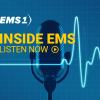Heart blocks present a significant challenge to EMTs and paramedics, demanding a high level of expertise and precision in both diagnosis and treatment. Understanding the nuances of different types of heart blocks is crucial for effective patient management. The ability to accurately recognize and differentiate between various heart blocks, such as bifascicular, trifascicular and other types, is not just a matter of academic understanding but a vital skill in the fast-paced environment of EMS.
In this episode of the Inside EMS podcast, cohosts Chris Cebollero and Kelly Grayson discuss how to train EMTs and paramedics to recognize, differentiate and treat heart blocks.
Memorable quotes
“Some of the drugs that we give are sometimes cause many problems as they solve.”
“One of the things that we’re talking about here is pacing. And I don’t think that that’s two things that we do very well in EMS. Paramedics don’t pace and paramedics don’t cardiovert. And one of the things that you’ve got to be able to remember is when those patients need both.”
“The best way to make an arrhythmia go away is to be prepared for the arrhythmia.”
Key takeaways
- Understanding heart blocks, Chris Cebollero and Kelly Grayson delve deep into the recognition and differentiation of heart blocks. Grayson emphasizes the challenge EMTs face in distinguishing between various heart blocks, such as bifascicular and trifascicular blocks, highlighting the need for thorough training and understanding.
- Treatment approaches. The podcast hosts discuss the traditional and contemporary treatment approaches to heart blocks, focusing on medications like atropine, lidocaine and procainamide. Grayson points out the delicate balance between treating the arrhythmia and avoiding exacerbating the patient’s condition.
- Electrical therapy preference. Both hosts advocate for the use of electrical therapy (“the Edison medicine”) in critical cases of arrhythmias. They stress the importance of pacing in cases of bradycardia and cardioversion in tachycardia, especially when the patient is hemodynamically unstable.
- Patient-centric care. A recurring theme is the importance of treating the patient, not just the monitor readings. This includes understanding when to apply treatments and recognizing when a wait-and-see approach might be more beneficial.
- Educational insights. Grayson shares his teaching methods, including the use of analogies and the “AV block cheat sheet” to simplify complex concepts for EMTs and paramedics in training.
This episode of the Inside EMS Podcast is sponsored by LogRx. Learn a better way to track your narcotics at LogRx.com.
EMS1 is using generative AI to create some content that is edited and fact-checked by our editors.








